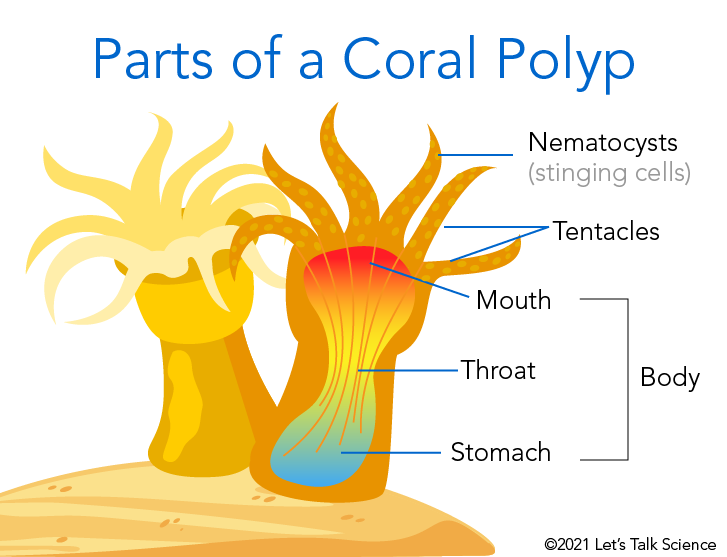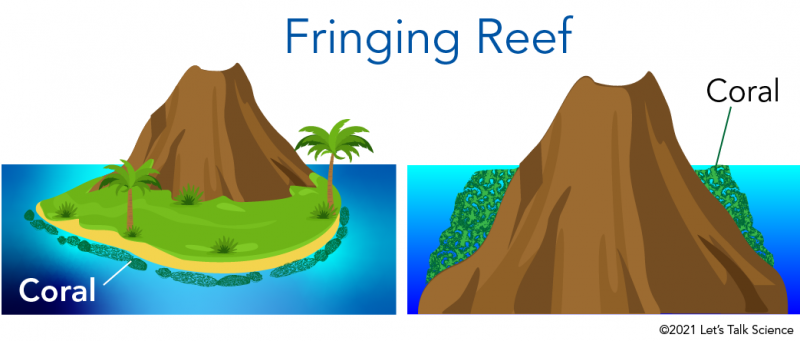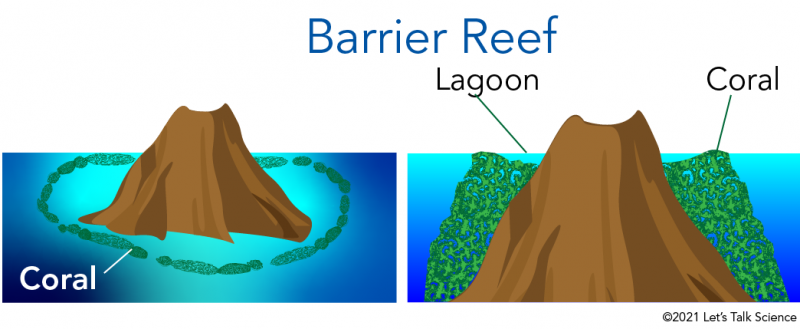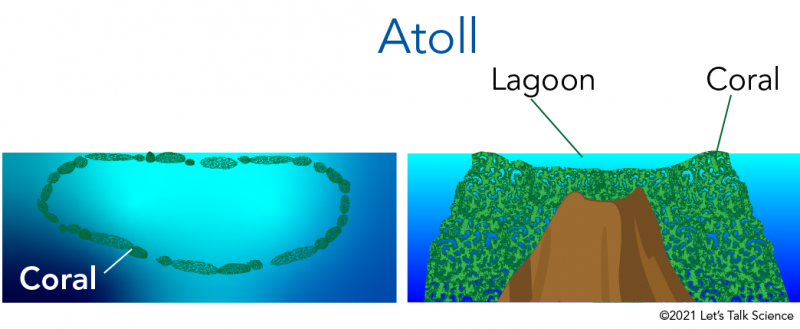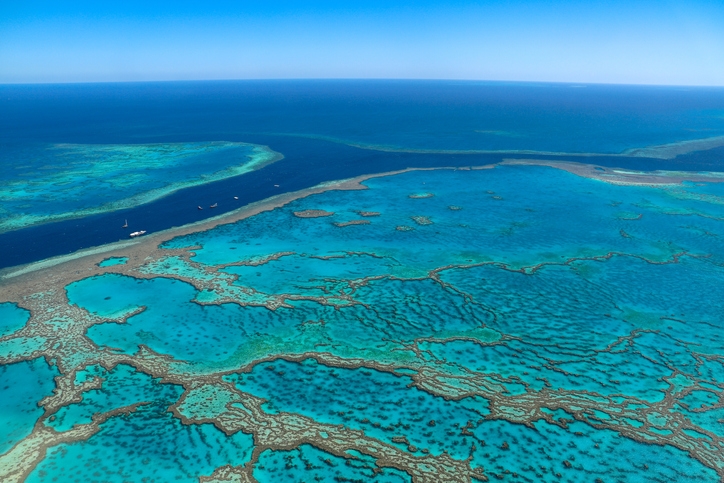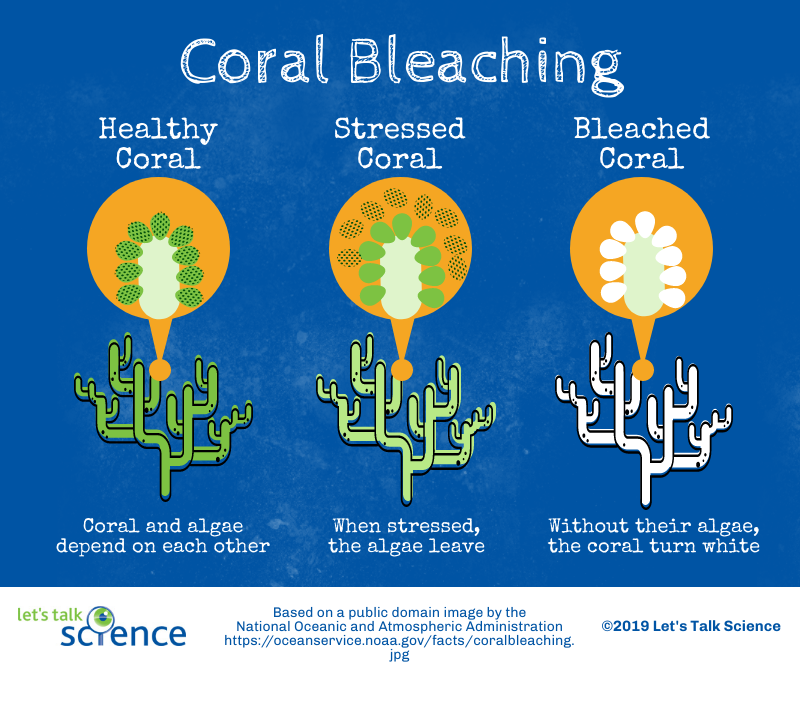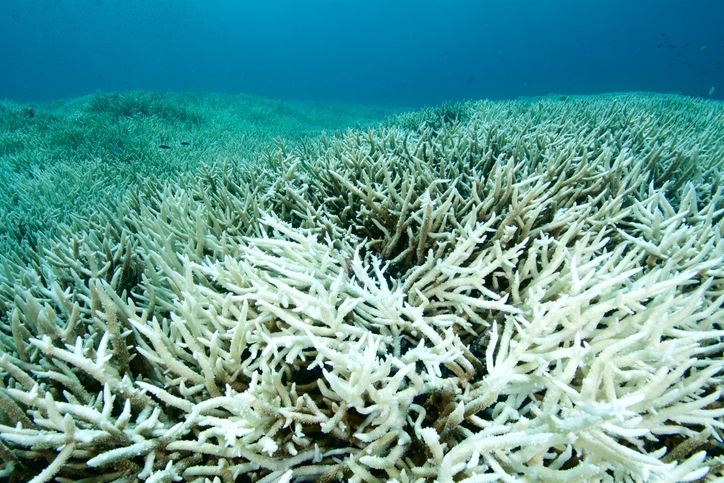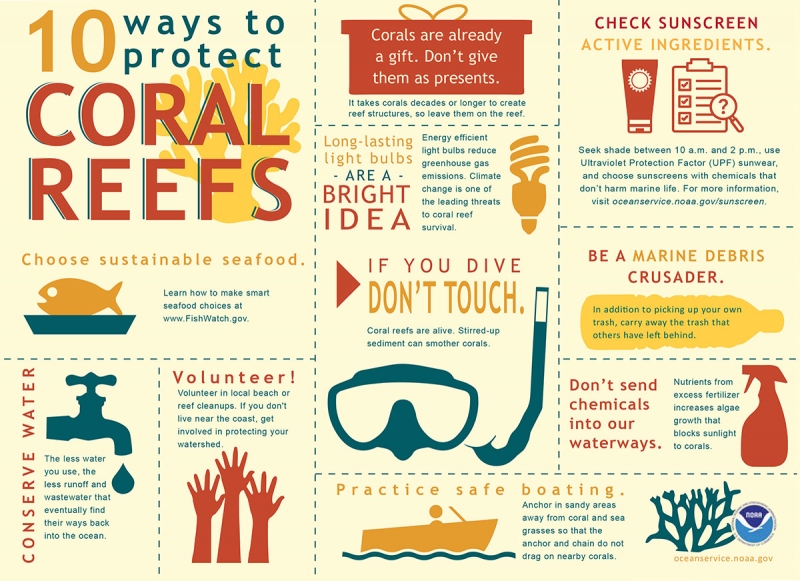Coral Ecosystems
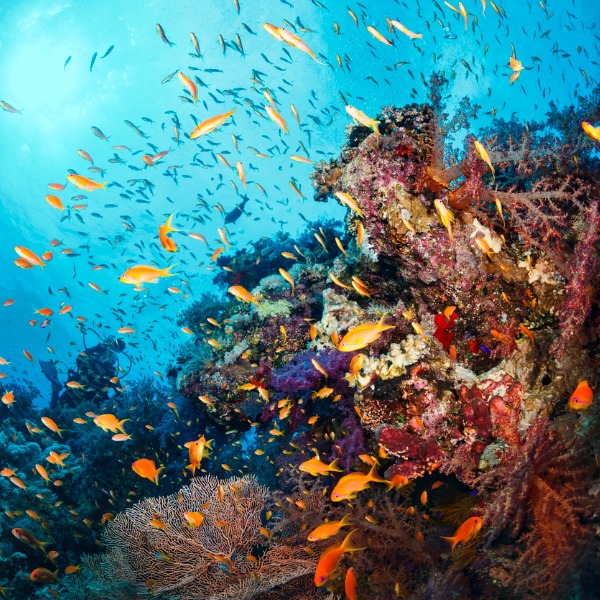
Coral reef (ultramarinfoto, iStockphoto)

Coral reef (ultramarinfoto, iStockphoto)
How does this align with my curriculum?
Learn about coral ecosystems and why they are important as well as what you can do to help keep them healthy.
What is a coral?
While many people think corals are beautiful plants, corals are actually marine animals! They are most closely related to other marine animals such as jellyfish and sea anemones.
What we see as a piece of coral is actually millions of individual polyps. Polyps are invertebrate animals with tentacles surrounding their mouth openings. Their tentacles are covered in stinging cells called nematocysts. These help polyps to defend themselves and capture prey.
Image - Text Version
Shown is an illustration of two coral polyps. One is shown as a front view and one as a cross-section.
A polyp has an elongated sac-like body that ends in thick finger-like projections. These projections are labelled as tentacles. On the tentacles are small, oval shapes. These are labelled as nematocysts. Nematocysts are stinging cells. The body is shown cut away. The interior has an hourglass shape. The shading in the interior transitions, top down, from red to yellow to blue. The region shaded red is labelled as the mouth. The region shaded yellow is labelled as the mouth and the region shaded blue is labelled as the stomach.
There are two main types of coral. These are hard, or stony corals and soft corals.
Image - Text Version
Shown are two groups of illustrations. On the left is a group identified as hard corals and on the right is a group identified as soft corals.
The group of hard corals includes corals in various shapes and colours. Some are tube shaped and some are branched while others look like the petals of a rose or a cluster of gems. They are in shades of yellow, brown, tan and pink.
The group of soft corals are all branched and frilly. They all have fine branching parts and tufts. They are in shades of yellow, pink, purple and blue.
When large networks of corals are found grouped together, they are called coral reefs. Coral reefs are a type of ecosystem. Coral reefs are home to many different kinds of coral but most reefs are built from hard corals.
Did you know?
There are many different kinds of corals. Learn about Pineapple Coral, Torch Coral and more!
There are three main types of Coral reefs:
Fringing Reef
Fringing reefs, also known as shore reefs, are the most common type of reef. These reefs grow close to the shore line and usually remain just below water level.
Image - Text Version
Shown are two colour illustrations of a fringed reef. The image on the left shows an island with a volcano, palm trees and a sandy beach. Around the island, and close to shore, are some vaguely oval, greenish shapes which are labelled as coral. The image on the right is a side view of the same island. The water level is about two thirds of the way up the island. Growing up from the sides of the island are coral formations. They come up to just above the surface of the water. One one side this is labelled as coral.
Barrier Reef
Barrier reefs are similar to fringing reefs except that they are separated from the shore by water that is often very deep. This water is called a lagoon.
Image - Text Version
Shown are two colour illustrations of a barrier reef.
The image on the left shows a small island with only the top of an old volcano above the water line. Around the island, somewhat away from shore, are some vaguely oval, greenish shapes which are labelled as coral.
The image on the right is a side view of the same island. The water level is about three quarters of the way up the island. Growing up from the sides of the island are coral formations. They come up to just above the surface of the water. One one side this is labelled as coral. Between the top of the coral formation and the island is water labeled as a lagoon.
Atoll
An atoll is a ring-shaped coral reef. An atoll surrounds a lagoon. It starts out as a fringing reef around a volcanic island. Over time, the coral grows and the volcanic island sinks into the ocean and just the ring of coral is left.
Image - Text Version
Shown are two colour illustrations of an atoll.
The image on the left shows a pale blue area of water surrounded by a ring of vaguely oval, greenish shapes which are labelled as coral.
The image on the right is a side view of the same place. There is a peak of an old volcano below the water level. Growing up from the sides and covering the top of the volcano are coral formations. The outer edges of the formation come up to just above the surface of the water. One one side of the formation is labelled as coral. Between the raised parts of the coral is a body of water labelled as a lagoon.
Check out this interactive map to where where different warm water coral reefs are located around the world.
The largest coral reef in the world is the Great Barrier Reef, which is located off the coast of Australia. This reef system is made up of over 2 900 individual reefs and covers an area of 344,400 square kilometres. It is believed that the Great Barrier Reef began growing about 20 000 years ago.
Image - Text Version
Shown is a colour photograph of one part of the Great Barrier Reef. A dark blue channel can be seen along the left side and top of the image. The rest of the picture is a pale turquoise blue in which gray branching structures are visible in the shallow water. These are the stony structures of the corals.
What Do Corals Eat?
Corals, like jellyfish and sea anemones, have stinging cells in their tentacles which shoot out harpoon-like parts to catch small fish and plankton for them to eat. Coral also get food from tiny algae called zooxanthellae. Algae can make food using the Sun's energy through a process called photosynthesis. The algae and the coral have a symbiotic relationship. The algae produce food for the coral and in exchange, the coral provides the algae with a safe place to live. This algae is also the reason for the vibrant colours of coral.
Why are Corals Important?
Healthy coral reefs provide homes to thousands of different species and are thought to be the most biodiverse ecosystems on the planet. Scientists believe that up to 2 million species live in coral reefs. Coral reefs also help human communities. Reefs can protect human communities against the impacts of climate change, including coastal erosion, flooding and life-threatening hurricanes. Research suggests that corals may also be a source of medicine. Corals are not just beautiful, they are important to our planet and its health!
Human Impacts
Corals are very sensitive animals. This means that they need very specific conditions to survive. Human activities that create greenhouse gas emissions and other pollution impacts coral in the following ways:
Image - Text Version
Shown is an infographic describing different impacts climate change can have on coral reef ecosystems. There are six panels with text and illustrations.
The first vertical panel has a top down colour gradient from blue to purple and text that indicates when oceans warm, there is greater stress from heat. This stress can lead to coral bleaching, infection and disease. Two whiteish corals are shown.
The second blue vertical panel has a pale blue area and text that indicates that with climate change come changing storm patterns which can result in stronger storms. Two brownish corals are shown.
The third vertical panel has a top down colour gradient from blue to tan and text that indicates as sea levels rise, more sediments are washed into oceans.This can result in corals being buried in sediment. Two tan-coloured corals are shown.
The fourth panel has a top down colour gradient from bright green to blue and text that indicates with more precipitation comes increased runoff from land. This runoff can result in algal blooms which can reduce the amount of light that coral can access. Two plants are shown.
The fifth panel has a swirly gradient of blues and tans and text that indicates when ocean currents change there can be changes in water temperature patterns. This means that corals may not be able to access as much food. Two colourful coral are shown.
The sixth panel has a top down colour gradient from blue to red and text that indicates when with increased carbon dioxide levels, the pH of the ocean goes down. This means that the ocean becomes more acidic. This can result in weaker coral. Two corals on their sides are shown.
Ocean Acidification
The burning of fossil fuels releases greenhouse gases, such as carbon dioxide into the atmosphere. The more carbon dioxide the ocean absorbs from the atmosphere, the more the pH of the ocean decreases. This makes the ocean more acidic. Changes in ocean pH levels weaken the structure of corals and make it harder for them to grow.
Ocean Warming
Due to the high level of greenhouse gases in our atmosphere, the Earth’s temperature is rising. This also raises the temperature of oceans. Ocean warming puts stress on coral that can lead to coral bleaching and disease.
The Intergovernmental Panel on Climate Change (IPCC) predicts that if ocean temperatures increase by 1.5°C this could lead to the loss of 90% of coral reefs, and an increase of 2°C could cause coral reefs to all but disappear.
Pollution
Corals need clean water to survive. Pollution from manufacturing, oil spills, agricultural runoff, microplastics and garbage makes it harder for coral to grow and reproduce. It also makes them more prone to diseases.
What is Coral Bleaching?
When stressed by these environmental pressures, corals can kick out their symbiotic algae! This means that the corals no longer have an important food source and they begin to die. With no algae, corals lose their bright colours and turn white or brown which is called coral bleaching. Coral bleaching is happening worldwide and is responsible for a large percentage of coral that has been killed.
Image - Text Version
Shown is an infographic about coral bleaching.Three illustrations of corals are shown.
On the left is an illustration of what is identified as a healthy coral. It is dark green in colour. Shown in closeup are green algae living on the polyps. Below this is text explaining that coral and algae depend on each other.
In the centre is an illustration of what is identified as stressed coral. It is pale green in colour. Shown in closeup are algae moving away from the polyps. Below this is text explaining that when stressed, the algae leave the coral.
On the right is an illustration of what is identified as bleached coral. It is white in colour. Shown in closeup are an absence of algae and white polyps. Below this is text explaining that without their algae, coral turn white.
Image - Text Version
Shown is a colour photograph of a large expanse of bleached staghorn coral. The extensively branching coral ranges from white to gray.
Did you know?
According to the Reef Resilience Network, the world has lost roughly half of its coral reefs in the last 30 years. Scientists expect that more than 90 % of corals will die by the year 2050.
Coral Conservation
Coral reefs across the world are in danger of becoming extinct. In order to stop coral from dying, humans need to change the way we treat our planet by:
- Switching to clean energy sources and using less fossil fuels.
- Reducing our greenhouse gas emissions to stop ocean warming.
- Cleaning up trash from the ocean and banning single-use plastic.
- Switching to eco-friendly fertilizers for farming.
While these things need the cooperation of people around the world, there are also local groups taking action.
- At the Bahamas Coral Innovation Hub, summer students with a passion for the ocean are working to save coral reefs by growing baby corals in a lab to then put back in the ocean.
- In West Maui, the Coral Reef Alliance is working to reduce sediment in the ocean which can prevent photosynthesis of zooxanthellae which leads to coral bleaching.
- On Hawai‘i Island, the Coral Reef Alliance is working with the Puakō community to address wastewater pollution.
- In 2019 Students Rebuild started the Ocean Challenge. In this challenge students and teachers from across the world learned about reefs and created ocean artwork which helped to raise $500,000 to protect coral reefs.
Did you know?
Some coral reefs are being designated as Marine Protected Areas (MPAs). Depending on the type of MPA, corals cannot be collected, damaged, fished or polluted!
Even if you don’t live in a place where corals grow, there are many things you can do at home and in your community to protect our coral.
Image - Text Version
Shown is an infographic that describes10 ways to protect coral reefs.
1. Beside an icon of a fish on a plate is the text, "Choose sustainable seafood. Learn how to make smart seafood choices at www.fishwatch.gov."
2. Beside an icon of a tap dripping water is the text, "Conserve Water. The less water you use, the less runoff and wastewater that eventually find their ways back into the ocean."
3. Beside an icon of three raised hands is the text, "Volunteer! Volunteer in local beach or reef cleanups. If you don't live near the coast, get involved in protecting your watershed."
4. Overlaid on an icon of a present is the text, "corals are already a gift. Don't give them as presents." Below this is text explaining that "It takes corals decades or longer to create reef structures, so leave them on the reef."
5. Beside an icon of a CF lightbulb is the text, "Long-lasting light bulbs are a bright idea. Energy efficient light bulbs reduce greenhouse gas emissions. Climate change is one of the leading threats to coral reef survival."
6. Above an icon of a snorkel and dive mask is the text, "If you dive, don't touch. Coral reefs are alive. Stirred-up sediment can smother corals."
7. Beside an icon of a sunscreen bottle and a checklist on a clipboard is the text, "Check sunscreen active ingredients. Seek shade between 10 am & 2 pm, use Ultraviolet Protection Factor (UPF) sunwear, and choose sunscreens with chemicals that don’t harm marine life. For more information, visit oceanservice.noaa.gov/sunscreen"
8. Beside an icon of a water bottle is the text, "Be a marine crusader. In addition to picking up your own trash, carry away the trash that others have left behind."
9. Beside an icon of a squirt bottle is the text, "Don't send chemicals into our waterways. Nutrients from excess fertilizer increase algae growth that blocks sunlight to corals."
10. Beside an icon of a rowboat, some coral and the NOAA logo is the text, " Practice safe boating. Anchor in sandy areas away from coral and sea grasses so that the anchor and chain do not drag on nearby corals."
Learn More
Allen Coral Atlas
This is an interactive Atlas of coral reefs across the world. Use the “Satellite Reef Imagery” tool to see the reefs appear.
Coral Gardening
This video (4:04) from BBC Earth introduces “Coral Gardening” a conservation strategy to help reefs survive.
Coral Reef Life - Explore the Oceans on Sea and Sky
This page of the Sea and Sky website has information about reef life, including many types of corals.
NOAA's Coral Reef Conservation Program (CRCP) - Coral Facts
This section of the National Oceanic and Atmospheric Administration website has lots about corals including anatomy, feeding habits, reproduction and more.
What Exactly Is Coral?
This video (6:57) from ABC Science explains how corals grow to form reefs, how they eat and why they are an essential part of ocean ecosystems.
What Would Happen If All The Coral Reefs Died Off?
This video (2:49) from Tech Insider explains what would happen if all the coral reefs died due to bleaching.
References
ABC Science (2017, Oct. 5). What Exactly Is Coral? [Video]. YouTube. https://www.youtube.com/watch?v=UkkfAzswGI8
Atlantic Productions (2015, Dec. 21). The Perfect Coral Reef - David Attenborough’s Great Barrier Reef: An Interactive Journey [Video]. YouTube. https://www.youtube.com/watch?v=EJXeMDVNsRk
Coral Reef CPR (n.d.). Reef Features. Retrieved from http://www.coralreefcpr.org/reef-types.html
Coral World Ocean Park (n.d.). Types of Coral Reefs. Retrieved from https://coralworldvi.com/coral-education/types-of-coral-reefs/
Derm, H. (n.d.). Polyps. Save The Corals. Retrieved from https://savethecorals.club/coral-polyps-diagrams-1
National Geographic (2017, Nov. 7). Coral Reefs 101 [Video]. YouTube. https://www.youtube.com/watch?v=ZiULxLLP32s
National Oceanic and Atmospheric Administration (n.d.) Coral Reef Ecosystems. Retrieved from https://www.noaa.gov/education/resource-collections/marine-life/coral-reef-ecosystems
National Oceanic and Atmospheric Administration (n.d.) NOAA Coral Reef Conservation Program. Retrieved from https://coralreef.noaa.gov/about/welcome.html
National Oceanic and Atmospheric Administration (n.d.) What are the Three Main Types of Coral Reefs? National Ocean Service. Retrieved from https://oceanservice.noaa.gov/facts/threecorals.html
Penniman, T. (2021). Coral Reefs: Strategies for Ecosystems on the Edge. International Institute for Sustainable Development. Retrieved from https://www.iisd.org/articles/coral-reefs-strategies-ecosystems-edge
